The main symptoms of an insect bite or sting are:
- pain or feeling itchy where you were bitten or stung
- a swollen lump on the skin
The lump may look red. But this may be more difficult to see on black or brown skin.
Different insect bites and stings will cause different symptoms.
Wasp and bee stings
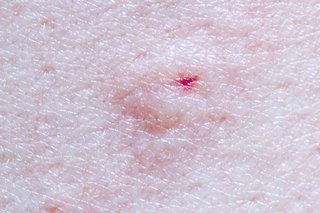
Wasp and bee stings cause a sharp pain in the area that's been stung. This usually lasts a few seconds.
Wasp and bee stings may cause a:
- swollen, itchy and painful mark to form - this may look red on some skin tones
- mild allergic reaction that lasts up to a week
- serious allergic reaction
A bee stinger usually stays in the wound.
Emergency action required: Call 112 or 999 or go to your nearest emergency department (ED) if
you have symptoms of a serious allergic reaction, such as:
- wheezing or difficulty breathing
- a swollen face, mouth, lips, tongue or throat
- eye pain or conjunctivitis
- nausea or vomiting
- a fast heart rate
- dizziness or feeling faint
- difficulty swallowing
- loss of consciousness
- a skin rash that may include itchy, red, swollen, blistered or peeling skin
Bed bug bites

Bed bug bites usually happen on your:
- face
- neck
- hands
- arms
The bites typically appear in a straight line on the skin.
They are not usually painful.
If you have not been bitten by bed bugs before, you may not have any symptoms.
If you have been bitten before, you may develop itchy bumps. These generally clear up on their own within a week.
Preventing bed bug infestations
Mosquito, midge or gnat bites
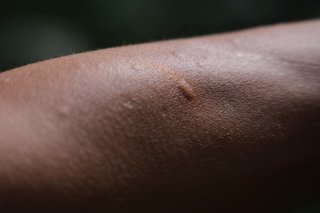
Mosquito, midge and gnat bites can cause small lumps on your skin. They are usually very itchy.
Some people may get:
- bullae - fluid-filled blisters
- weals - circular, fluid-filled areas around the bite
Do not burst a blister - it could get infected.
Mosquitoes do not cause major harm in Ireland. But in some parts of the world, they can cause malaria and other potentially serious infections.
Taking care when travelling abroad
Spider bites
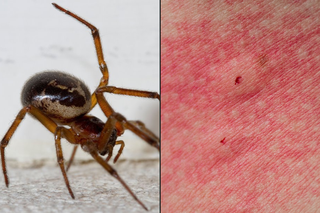
Spider bites are not common in Ireland. But some spiders such as the false widow spider can give a nasty bite.
Some spiders in Ireland are venomous.
Spider bites leave small puncture marks on the skin. They can be painful and cause redness and swelling. They can become infected.
Their bites can cause:
- nausea
- vomiting
- sweating
- dizziness
- a serious allergic reaction in rare cases
Emergency action required: Call 112 or 999 or go to your nearest emergency department (ED) if
you have symptoms of a serious allergic reaction, such as:
- wheezing or difficulty breathing
- a swollen face, mouth, lips, tongue or throat
- eye pain or conjunctivitis
- nausea or vomiting
- a fast heart rate
- dizziness or feeling faint
- difficulty swallowing
- loss of consciousness
- a skin rash that may include itchy, red, swollen, blistered or peeling skin
Ant stings and bites
The most common ant in Ireland is the black garden variety. It does not sting or bite.
Ants that can sting include:
- red ants
- wood ants
- flying ants
Ant bites and stings are generally harmless. You'll probably feel a nip and a mark may develop on your skin. This mark may look pale pink on some skin tones.
Sometimes the bitten area may be painful, itchy and swollen.
Horsefly bites
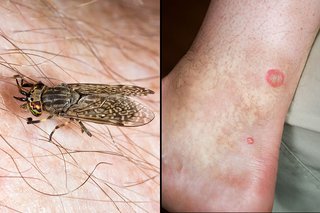
A horsefly bite can be very painful. The bitten area of skin is usually raised and may look red on some skin tones.
You may also experience:
- urticaria or hives - a large raised rash
- dizziness
- weakness
- wheezing
- parts of your body becoming puffy and swollen
Horsefly bites can take a long time to heal and can become infected.
Non-urgent advice: Contact your GP if
you have symptoms of a wound infection such as:
- pus
- increasing pain
- redness
- swelling
Flea bites
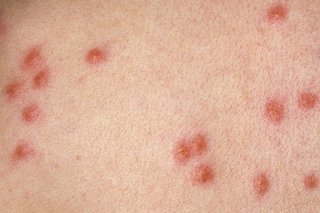
Flea bites can cause small, itchy lumps. They are sometimes grouped in lines or clusters. They may look red on some skin tones.
You may also get bullae (fluid-filled blisters).
Fleas from cats and dogs often bite below the knee, usually around the ankles. You can also get flea bites on your arms if you've been stroking or holding your pet.
Tick bites

Tick bites are not usually painful.
Symptoms of a tick bite can include:
- a small lump on the skin - this may look red on some skin tones
- swelling
- itchiness
- blistering
- bruising
Ticks in Ireland can sometimes carry an infection called Lyme disease. But most tick bites are harmless.
Important
Remove any ticks you find as soon as possible to reduce your risk of getting Lyme disease.
Non-urgent advice: Contact your GP if
you develop any symptoms of Lyme disease such as:
- a fever
- a rash that looks like a bull's-eye on a dart board
Mite bites
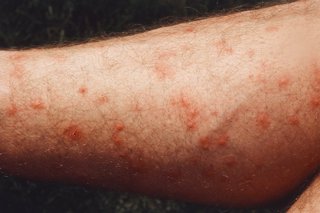
Mite bites cause very itchy lumps to develop on the skin. They can also cause blisters.
Mites usually bite uncovered skin. You may be bitten on your tummy and thighs if your pet has mites and has been sitting on your lap.
Some mites burrow into the skin and cause a condition called scabies.
Caterpillar hairs
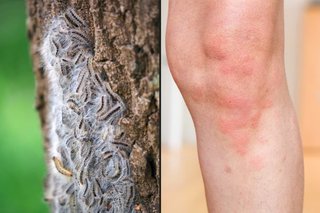
Caterpillars of the oak processionary moth are harmful. They have tiny hairs that can be blown around by the wind.
These hairs can cause:
- different types of rashes
- itchy skin
- eye and throat irritation
- breathing difficulties in people and animals, but this is not common
The caterpillars of the oak processionary moth and their nests are usually found on oak trees. But this moth is very rare in Ireland.
Report any suspected sighting of the oak processionary moth caterpillar to the Horticulture and Plant Health Division of the Department of Agriculture, Food and the Marine.
How to remove caterpillar hairs
When to contact your GP
Non-urgent advice: Contact your GP if:
- you were stung more than once
- your symptoms do not get better within a few days or are getting worse
- you were stung or bitten in your mouth or throat, or near your eyes
- an area that is 10cm or more around the bite becomes swollen
- you have symptoms of a wound infection, such as pus, pain, swelling or redness
- you have symptoms of a widespread infection, such as a fever, swollen glands and other flu-like symptoms
Emergency action required: Call 112 or 999 go to your nearest ED if
you have symptoms of a serious allergic reaction, such as:
- wheezing or difficulty breathing
- a swollen face, mouth, lips, tongue or throat
- eye pain or conjunctivitis
- nausea or vomiting
- a fast heart rate
- dizziness or feeling faint
- difficulty swallowing
- loss of consciousness
- a skin rash that may include itchy, red, swollen, blistered or peeling skin
Content supplied by the NHS and adapted for Ireland by the HSE
